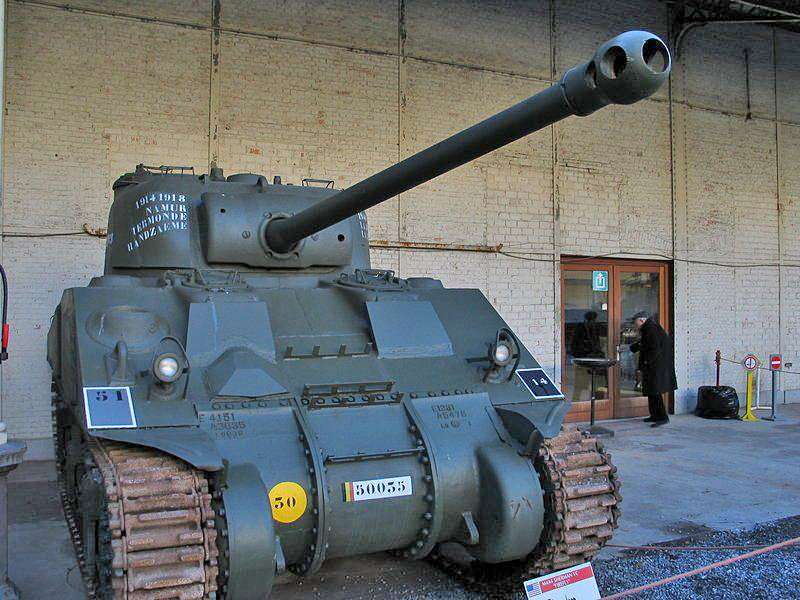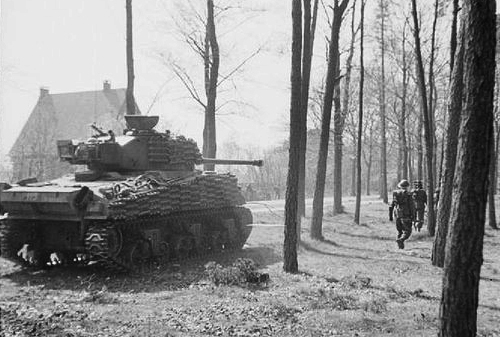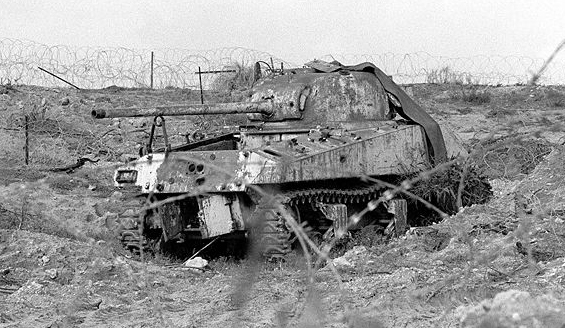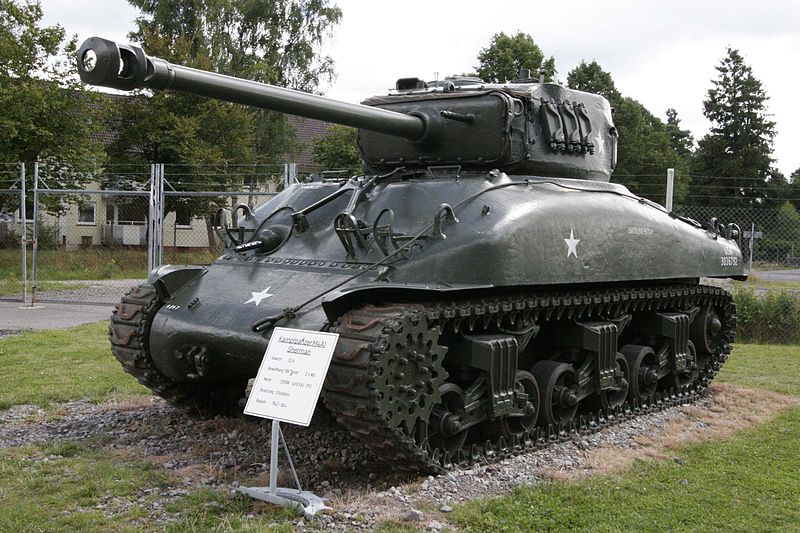Turning the Sherman into a killer
From the hedgerow of Normandy, France to the hills of Italy and the plains of Netherlands, the Firefly was one of the few allied tanks the Germans learned to fear… Among the most potent allied conversion of the war, and certainly one of the deadliest version of the Sherman, it was a clever -although risky and improvized- move to try to keep up with the latest German tank developments. At that time, the “basic” M4 Sherman equipped the allies at large, from the US to the British, Canadian, ANZACS, Free Polish and Free French, and its limitations were barely known before 1944.
Its basic 75 mm gun was excellent to deal with other tanks at reasonable ranges and against armour up to 75 mm, or against fortifications and infantry. But facing the latest versions of the panzer IV, the Panther and Tiger, it was woefully inadequate, whereas the British Army received the superlative 17 pounder, which proved itself to nail any known Panzer. Mated with the Sherman, this stopgap combination (before the new generation could enter service) became lethal, and added its own weight to the allied effort to secure victory.
Preserved Firefly, showing its camouflaged barrel, as of 2008.
Adoption
The idea of putting the 17 pdr in a Sherman was long opposed by the Ministry of Supply. It was largely due to the efforts and perseverance of two officers, British Major George Brighty, with the help of Lieutenant Colonel Witheridge, an experienced veteran of the NA campaign, wounded at Gazala. Despite reports and refusals, they managed to pursue the project by themselves and eventually get the concept accepted before massive delays began to appear in the development of official projects. Brightly already made attempts at the Lulworth Armoured Fighting School in early 1943. This first version had the whole recoil system removed, locking in effect the gun in place, while the tank bluntly absorbed the recoil. Witheridge joined Brighty about the doubts of the Challenger being ready in time and lobbied actively to the same idea, providing his assistance and solving the recoil problem.
They received a note from the Department of Tank Design to cease their efforts, but thanks to Witheridge connections, they eventually convinced the head of the Royal Armoured Corps, and then won the Director General of Weapon and Instrument Production, and the ministry of supply, which ultimately gave them full support, funding, and an official approval. In October-November 1943 already, enthusiasm and knowledge about the project grew and in early 1944 before the new delays of the Challengers and inability of the Cromwell turret ring to receive the 17 pdr, the programme was eventually given the ‘highest priority’ by Winston Churchill himself in preparation for D-Day.

Ex Dutch Firefly preserved at the Cavalry Museum Amersfoort
About the 17 pounder
This legendary piece of ordnance was the first of the many ROF (Royal Ordnance Factory) cannons called to fame postwar, like in particular the rifled L7 105 mm, and later the L30 120 mm that was given to the Chieftain and Challengers. The 17\’ was a 76.2 mm of 55 calibres, which had a 2,900 ft/s (880 m/s) muzzle velocity with HE, HEAT rounds and 3,950 ft/s (1,200 m/s) with APDS or Armour Piercing, Capped, Ballistic Capped. This figures allowed it to defeat any armour in the range of 120-208 mm in thickness at 1,000 m and up to 1,500 m with the APDS.
The design was ready in 1941 already, and production started in 1942. It proved itself time and again in Tunisia, Sicily and Italy, with the first action in February 1943. So the idea to have it inside a tank turret was a priority since the QF 6-pdr was found inadequate by 1943. However the 17 pounder was long and heavy, therefore needed much reworking and compromises to have it installed in a turret, and intermediary solutions had to be found. by 1944, the Archer used it, as the Achilles (M10 Wolverine), the Challenger, and later the Comet.

17 pdr ammo rounds being loaded by the crew; Notice the camouflage nets around the turret, mantlet and gun barrel
Conversion design
The genius was to succeed in cramming the heavy gun into a turret it was never designed for. By doing it, W.G.K. Kilbourn, a Vickers engineer that took on the issues of such project allowed a quick adaptation to the most prolific allied tank, thus ensuring no change in maintenance, supply and transport chains, quite critical factors after D-Day. Although there were few changes made in the chassis of mostly Mk.IC hybrids (cast glacis) and mark Vs, but modified ammo cradles and the hull gunner eliminated to make room. The turret interior was also completely modified: The rear was emptied to make room for the recoil, and a counterweight was added to balance the long barrel protruding at the front. This “bustle” now housed the radio, formerly at the back of the turret, and could be accessed by a large hole in the casting. The mantlet was also modified, 13 mm thicker than the original, as well as the position of the loader. A new hatch had to be cut into the top of the turret over the gunner\’s position to allow his access/escape since the size of the new gun prevented the gunner to use the normal hatch.
But the 17-pdr itself still had a one meter long recoil course, and the whole recoil system was completely modified. The main recoil cylinders were shortened while additional new cylinders were added to take advantage of the turret width. The gun breech was rotated 90 degrees to allow a left loading. The gun cradle had to be shortened also, which caused stability concerns, solved by the adoption of a longer untapered section at the base of the barrel. Therefore the 17-pdr has its own version tailored for the Firefly.

British Sherman Firefly at the battle of the Bulge
The Firefly in Action
The Firefly was ready in numbers and filled the 21st Army Group armoured brigades in 1944, just in time for D-Day. Fortunately, because intelligence did not anticipated the presence among others of Panther tanks en masse, quite formidable adversaries for the Sherman. Ken Tout summed up his impressions about the Firefly, then at the 1st Northamptonshire Yeomanry: “The Firefly tank is an ordinary Sherman but, in order to accommodate the immense breech of the 17-pounder and to store its massive shells, the co-driver has been eliminated and his little den has been used as storage space. … The flash is so brilliant that both gunner and commander need to blink at the moment of firing. Otherwise they will be blinded for so long that they will not see the shot hit the target. The muzzle flash spurts out so much flame that, after a shot or two, the hedge or undergrowth in front of the tank is likely to start burning. When moving, the gun\’s overlap in front or, if traversed, to the side is so long that driver, gunner and commander have to be constantly alert to avoid wrapping the barrel around some apparently distant tree, defenceless lamp-post or inoffensive house”

British Firefly Crossing a bridge, Operation goodwood
Fortunately also the Firefly was present, because the British and Commonwealth units had to face over 70% of all German armour deployed during the Battle of Normandy, including the much-feared SS Panzer units, in particular around Caen. In turn, the Germans learnt to recognise and respect the Firefly, which became often their #1 priority target in most engagements such was the damage they inflicted. In response, the crews usually painted the protruding half of the barrel with an effective countershading pattern to try to disguise it as a regular Sherman. Common tactic was to place the Fireflies in good hull-down positions in support of other Shermans, covering them in the advance each time an enemy tank will reveal itself, at least in theory.
Their effectiveness rapidly became legendary, as testified by the most enviable hunting scores of all allied tanks, including against the most feared German top ace tank commanders like Michael Wittman, presumably destroyed by a Canadian Firefly (see later). On 9 june for example, Lt. G. K. Henry\’s Firefly knocked-out five Panthers in rapid succession from the 12th SS Panzer Division in the defense of Norrey-en-Bessin on june, 9, 1944. Other Shermans were credited for two more, oiut of 12, repelling the attack. On june 14, Sgt. Harris of the 4th/7th Dragoon Guards decimated five Panthers around the hamlet of Lingèvres, near Tilly-sur-Seulles, changing position in between. The most famous action was credited to Ekins, the gunner of Sergeant Gordon\’s Sherman Firefly from the Sherbrooke Fusiliers Regiment, A-Sqn, which destroyed three Tigers in a row, one presumably from Michael Wittman on Cintheaux in August 1944.

Fireflies of the Irish Guards group, operation Market Garden
In total, the 1900+ Fireflies were used by the 4th, 8th, 27th, 33rd armoured brigades, the Guards Armoured Division and the 7th and 11th Armoured Division in Normandy and north-western Europe, which includes the Netherlands and Northwestern Germany. In Italy, it was deployed by the British 1st and 6th Armoured Divisions. The Canadians had Fireflies with the 1st (italy), 2nd brigades and inside the 4th and 5th Canadian Armoured Divisions, mostly in north-west Europe in 1945. The 1st Czechoslovak Armoured Brigade operated 36 Firefly 1Cs during the siege of Dunkirk in 1944, the 4th New Zealand Armoured Brigade had some for its Italian campaign, as well as the Polish 1st Armoured Division (NW Europe) and 2nd Armoured Brigade (Italy), and the 6th South African Armoured Division in Italy. After the war, Fireflies were still used by Italy, Lebanon (until the 1980s), Argentina, Belgium and the Netherlands (until the late 1950s).
Links on the Firefly
The Firefly on Wikipedia
Firefly Gun barrel camouflage
Firefly reconstruction in the Netherlands
Video (short doc)
Sherman Firefly specs. |
|
| Dimensions (L/w/h) | 19.4 (25.6 oa) x 8.8 x 9 ft.in (5.89/7.77 oa x 2.64 x 2.7 m) |
| Total weight, battle ready | 37,75 long tons (35.3 tons) (83,224 ibs) |
| Crew | 4 (commander, driver, gunner, loader) |
| Propulsion | Multibank/radial petrol engine 425 hp 11hp/ton |
| Suspension | HVSS |
| Top Speed | 40 km/h (25 mph) |
| Range (road) | 193 km (120 mi) |
| Armament | Main: ROF OQF 17 Pdr Vickers (76.2 mm) 77 rounds Sec: Roof cal.50 (12.7 mm) Browning M2, coaxial cal.30 (7.62 mm) Browning M1919, 5000 rounds |
| Armour | 90 mm max turret front |
| Total production | 2000+ in 1944-45 |

Firefly Ic hybrid from a Polish armoured unit, Italy 1944.
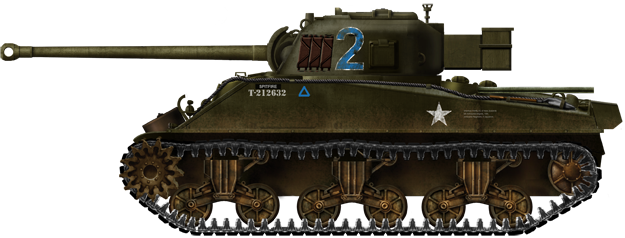
British Sherman Firefly Ic, East riding Yeomanry, 27th Armoured Brigade, Normandy, 6 june 1944

Firefly Ic, East riding Yeomanry, B Sqn, 27th Armoured Brigade, 11th armoured division, Normandy summer 1944.

Firefly VC, 14th Regiment, Royal Armoured Corps 33th Armoured Brigade, july 1944

Firefly VC 3rd County of London Yeomanry, 4th Armoured Brigade, Normandy summer 1944.

Firefly VC,4/7th Royal Dragoon Guards, 3th Armoured Brigade, France, 1944.
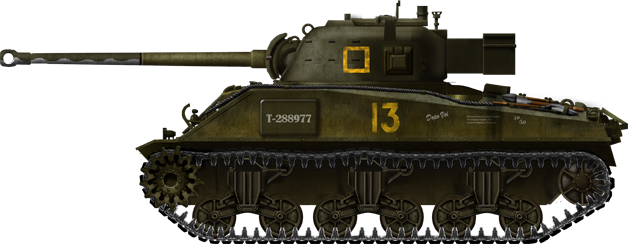
Firefly Mk.VC “Dopo voi” New Zealand 15th Armoured Regiment, 4th Armoured Brigade, Trieste, Italy, may 1945.

New Zealander Firefly VC “Peacemaker”, 15th Armoured Regiment, 4th Armoured Brigade, Adriatic front, Italy 1945

Rare MkIc composite Firefly Tulip, the ultimate tank hunter. It was given Hawker Typhoon AP rockets.
Gallery

WW2 Tanks




























WW2 tanks posters

All Tiger tanks liveries.

Panther liveries and variants

WW2 Armour - All tanks











Tanks aces and single tanks series

Find more there

Museums, Movies, Books & Games
The Tanks and Armor in pop culture
Tanks and armored vehicles in general are only really grasped when seen first person: The mass, the scale, it's all there. Explore also the way tanks were covered in the movie industry, in books and in video games.Movies:
Best tanks movie on warhistoryonline.com
On imdb.com
On bestsimilar.com/
miltours.com
liveabout.com/
watchmojo.com
Video Games:
pcgamesn.com
historyhit.com
levvvel.com
vg247.com/best-tank-games
mmobomb.com/
alienwarearena.com


 Tank hunter (1944)
Tank hunter (1944) 

